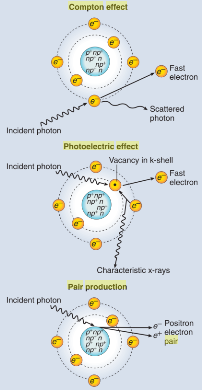Coherent scattering occurs in the event of low radiation energy, limiting photon-electron interaction. The process happens when a photon passes a medium, but it can neither attract the electron nor cause power deposition owing to insufficient strength, although it changes direction, resulting in a systematic dispersion (Niederhuber et al., 2019). Accordingly, the operation transpires because the atom’s ionization energy exceeds that of the X or gamma rays.
Compton scattering is a photon activity that results from a photon and electron attraction. The procedure involves a photon pulling a free or a loose electron from an atom’s outer shell. Due to the difference in the photon and binding energies, the photons assume a new wavelength upon absorption and scatter, as illustrated below (Niederhuber et al., 2019). Therefore, Compton scattering exists since the photon energy exceeds the binding force.

The photoelectric effect is a phenomenon that arises when light hits a metal surface. It materializes when light excites electrons, making them mobile, as shown above (Niederhuber et al., 2019). Consequently, the incident rays strike the material, and the electrons soak up the energy and resist the binding pressure, ultimately jumping out. Some of the factors determining the photoelectric effect include the light’s strength, frequency, and intensity, material type, and the potential difference.
Pair production encompasses the creation of two electrons with different charges, whereas photodisintegration is a nucleus event. Pair production proceeds when the photon energy is higher than that of either electrons. Subsequently, the electromagnetic pressure traverses the material and energizes the electrons giving rise to an electron and a positron, as illustrated in the image above (Niederhuber et al., 2019). However, in photodisintegration, photons eject protons or neutrons from the atom’s nucleus (Niederhuber et al., 2019). Correspondingly, it absorbs the gamma rays and disintegrates into a subatomic material.
Reference
Niederhuber, J. E., Armitage, J. O., Doroshow, J. H., Kastan, M. B., & Tepper, J. E. (2019). Abeloff’s clinical oncology e-book (6th ed.). Elsevier Health Sciences.